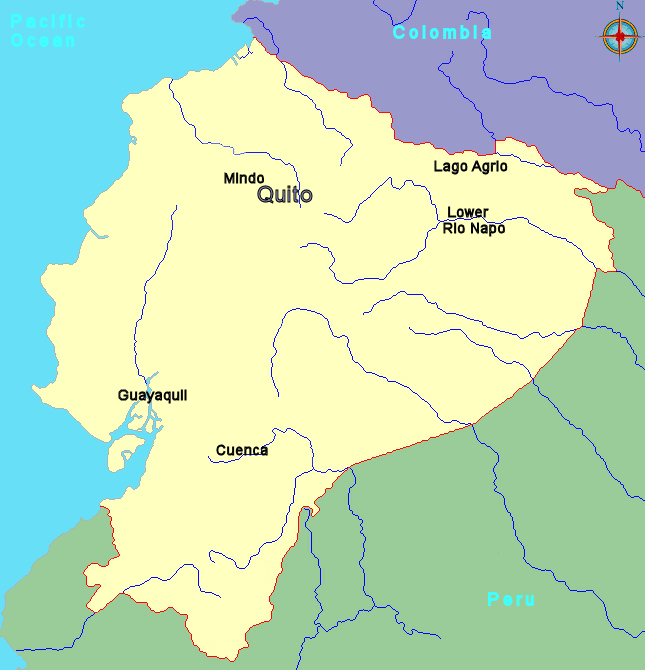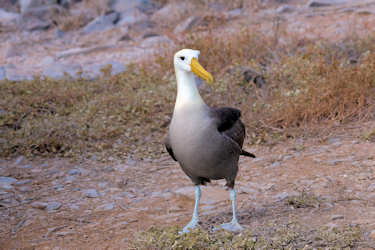Ecuador

Historie
Various peoples had settled in the area of the future Ecuador before the arrival of the Incas. Some likely sailed to Ecuador by rafts
from Central America and others came to Ecuador via the Amazon tributaries or through the Andes. Even though their languages were unrelated,
these groups developed similar groups of cultures, each based in different environments. The people of the coast developed a fishing, hunting
and gathering culture; the people of the highland Andes developed a sedentary agricultural way of life; and the people of the Amazon basin
developed a nomadic hunting-and-gathering mode of existence.
Over time these groups began to interact and intermingle with each other so that groups of families in one area became one community or tribe, with
a similar language and culture.
Many civilizations arose in Ecuador, such as the Valdivia Culture and Machalilla Culture on the coast,
the Quitus and the Cañari in the highre Andes. Each civilization developed its own distinctive architecture, pottery, and religious
interests.
When the Incas arrived, they found that these civilizations were so developed that it took them two generations of rulers – Topa Inca Yupanqui
and Huayna Capac to absorb them into the Inca Empire, which was completed in 1463.
In contrast, when the Incas made incursions into coastal Ecuador and the eastern Amazon jungles of Ecuador, they found both the environment and indigenous
people more hostile. Moreover, when the Incas tried to subdue them, these indigenous people withdrew to the interior and resorted to guerrilla tactics. As
a result, Inca expansion into the Amazon basin and the Pacific coast of Ecuador was hampered.
The Spanish conquest of the Inca Empire was one of the most important campaigns in the Spanish colonization of the Americas. After years of preliminary
exploration and military skirmishes, 180 Spanish soldiers under conquistador Francisco Pizarro and their native allies captured the Sapa Inca
Atahualpa in the 1532 Battle of Cajamarca.
It was the first step in a long campaign that took decades of fighting but ended in Spanish victory in 1572 and colonization of the region as the
Viceroyalty of Peru.
It remained a part of the Viceroyalty of Peru until 1720, when it joined the newly created Viceroyalty of New Granada; within the viceroyalty,
however, Ecuador was awarded its own audiencia in 1563, allowing it to deal directly with Madrid on certain matters.
October 9, 1820, Guayaquil became the first city in Ecuador to gain its independence from Spain. The rest of Ecuador gained its independence after
Antonio José de Sucre defeated the Spanish Royalist forces at the Battle of Pichincha, near Quito. Following the battle, Ecuador joined
Simón Bolívar's Republic of Gran Colombia, also including modern-day Colombia, Venezuela and Panama. In 1830 Ecuador separated from Gran Colombia and
became an independent republic.
The Liberal Revolution of 1895 was a period of radical social and political upheaval. The Revolution started on June 5, 1895 and ultimately resulted
in the overthrow of the conservative government, which had ruled Ecuador for several decades, by the Radical Liberals, led by Eloy Alfaro. After
the revolution, the new government legalized divorce, allowed religious freedom, and weakened the authority of the Church, which lost the land it held.
The Revolution is often seen as marking the birth of modern Ecuador, with a new power structure that favored the Liberal Party, and new infrastructure
projects such as the construction of a railway line between Quito and Guayaquil.
Ecuador during its long and turbulent history has lost most of its contested territories to each of its more powerful neighbors, such as Colombia in 1832
and 1916, Brazil in 1904 through a series of peaceful treaties, and Peru after a short war in which the Protocol of Rio de Janeiro was signed in 1942.
Much of the 20th century was dominated by José María Velasco Ibarra, whose five presidential terms began with a mandate in 1934 and final presidency
ending in 1972.
In 1972, a "revolutionary and nationalist" military junta led by General Guillermo Rodríguez overthrew the government of Velasco Ibarra. He
remained in power until 1976, when he was removed by another military government.
Colonel Richelieu Levoyer, Government Minister, proposed and implemented a plan to return to the constitutional system through universal elections.
Elections were held on April 29, 1979, under a new constitution. Jaime Roldós Aguilera was elected president, garnering over one million votes, the
most in Ecuadorian history. He took office on August 10, as the first constitutionally elected president after nearly a decade of civilian and military
dictatorships.
Aguilera governed until May 24, 1981, when he died along with his wife and the minister of defense, Marco Subia Martinez, when his Air Force plane crashed
in heavy rain near the Peruvian border. He was immediately succeeded by Vice President Osvaldo Hurtado, who was followed in 1984 by León Febres
Cordero.
Rodrigo Borja Cevallos won the presidency in 1988. His government was committed to improving human rights protection and carried out some reforms,
notably an opening of Ecuador to foreign trade.
The emergence of the Amerindian population as an active constituency has added to the democratic volatility of the country in recent years. The population
has been motivated by government failures to deliver on promises of land reform, lower unemployment and provision of social services, and historical
exploitation by the land-holding elite. Their movement, along with the continuing destabilizing efforts by both the elite and leftist movements, has
led to a deterioration of the executive office. The populace and the other branches of government give the president very little political capital, as
illustrated by the most recent removal of President Lucio Gutiérrez from office by Congress in April 2005. Vice President Alfredo Palacio
took his place and remained in office until the presidential election of 2006, in which Rafael Correa gained the presidency.
My first visit to Ecuador was in december 2016
These are the places I have seen on that trip
Quito
Mindo
Lower Río Napo
Galapagos Islands
My second trip to Ecuador was in november 2018
These are the places I have seen on that trip
Mindo
Lago Agrio
Lower Río Napo
Cuenca
Guayaquil
Please let me know when you're having questions.
i would be pleased to help you.
Things to do and other tips
